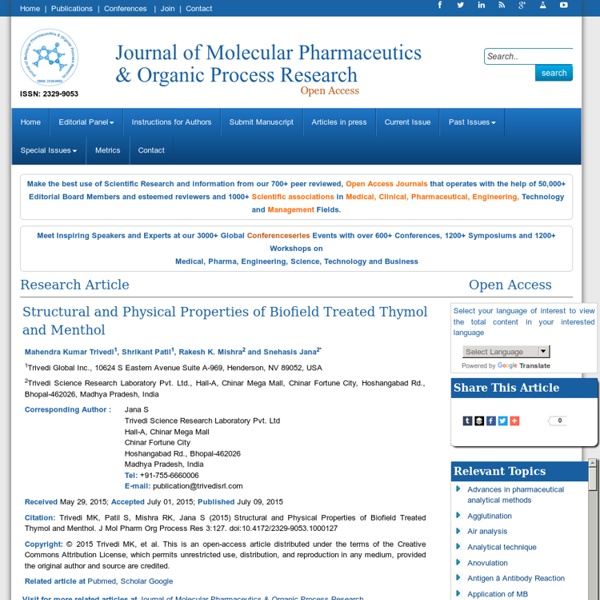



Spectroscopic Characterization of Biofield Treated Metronidazole and Tinidazole | Open Access | OMICS International Abstract Metronidazole and tinidazole are widely used antimicrobial drugs against Gram-negative and Gram-positive anaerobic bacteria. The present study was aimed to evaluate the impact of biofield treatment on metronidazole and tinidazole using FT-IR and UV spectroscopy. The study was carried out in two groups i.e. control and treatment. Characterization of Physical and Structural Properties of Aluminium Carbide Powder: Impact of Biofield Treatment | Open Access | OMICS International Abstract Aluminium carbide (Al4C3) has gained extensive attention due to its abrasive and creep resistance properties. Aim of the present study was to evaluate the impact of biofield treatment on physical and structural properties of Al4C3 powder. The Al4C3 powder was divided into two parts i.e. control and treated. Control part was remained as untreated and treated part received biofield treatment. Subsequently, control and treated Al4C3 samples were characterized using X-ray diffraction (XRD), surface area analyser and Fourier transform infrared spectroscopy (FTIR). Tables at a glance Figures at a glance
Effect of Bio Field Treatment on the Physical and Thermal Characteristics of Vanadium Pentoxide Powders | Open Access | OMICS Publishing Group Make the best use of Scientific Research and information from our 700+ peer reviewed, Open Access Journals that operates with the help of 50,000+ Editorial Board Members and esteemed reviewers and 1000+ Scientific associations in Medical,Clinical,Pharmaceutical,Engineering, Technology and Management Fields. Meet Inspiring Speakers and Experts at our 3000+ Global Conferenceseries Events with over 600+ Conferences, 1200+ Symposiums and 1200+ Workshops on Medical, Pharma, Engineering, Science, Technology and Business
"Biofield and Fungicide Seed Treatment Influences on Soybean Productivi" by Mahendra Kumar Trivedi Description Soybean production in Iowa USA is among the most productive for raínfed regions in the world. Despite generally having excellent soils, growing season temperatures and rainfall, soybean yields are decreased by weed interference and inadequate available soil water at key stages of crop development. A field study was conducted at two locations in lowa in 2012 to determine if seed-applied fungicide or biofield treatments influenced weed community, soil volumetric water concentration and soybean yield and quality. Application of biofield treatment resulted in lower density of tall waterhemp density, greater soybean stand density at R8 stage and greater seed pod-1 compared to the absence of seed fungicide and biofield Soil volumetric water content varied by seed fungicide x biofield x date interaction but differences were not consistent among treatment combinations. Citation Information Mahendra Kumar Trivedi.
Thermal and Physical Properties of Biofield Treated Bile Salt and Proteose Peptone | Open Access | OMICS International Abstract Bile salt (BS) and proteose peptone (PP) are important biomacromolecules being produced inside the human body. The objective of this study was to investigate the influence of biofield treatment on physicochemical properties of BS and PP. The study was performed in two groups (control and treated). The control group remained as untreated, and biofield treatment was given to treated group. The control and treated BS and PP samples were characterized by particle size analyzer (PSA), Brunauer-Emmett-Teller (BET) analysis, differential scanning calorimetry (DSC), x-ray diffraction (XRD), and thermogravimetric analysis (TGA). Tables at a glance Figures at a glance
Potential Impact of BioField Treatment on Atomic and Physical Characteristics of Magnesium | Open Access | OMICS International Abstract Magnesium (Mg), present in every cell of all living organisms, is an essential nutrient and primarily responsible for catalytic reaction of over 300 enzymes. The aim of present study was to evaluate the effect of biofield treatment on atomic and physical properties of magnesium powder. Tables at a glance Figures at a glance An Impact of Biofield Treatment: Antimycobacterial Susceptibility Potential Using BACTEC 460/MGIT-TB System | Open Access | OMICS International The aim of this study was to determine the impact of biofield treatment on susceptibility patterns of anti-tubercular drugs to XRD and MDR strains of Mycobacterium. For this purpose we had selected all three generations drugs, which are used to treat both MDR as well as XDR strains (Table 1). The overall alteration of responses (resistance and susceptibility) of antitubercular drugs after biofield treatment against XDR strains of Mycobacterium with respect to control are presented in Figure 1. Based on existing literatures isoniazide resistance developed due to loss of catalase activity [19], transformation of functional katG gene, deletions and mutation of others gene such as InhA [16]. In this experiment after the biofield treatment resistance property was reduced 26.7% in isoniazide as compared to control; it could be due to some interaction at genetic level. Mono-resistance to isoniazid is quite common and rifampin is rare.
"Physicochemical and Spectroscopic Characterization of Biofield Treated" by Mahendra Kumar Trivedi Description The antioxidants play an important role in the preservation of foods and the management of oxidative stress related diseases by acting on reactive oxygen species and free radicals. However, their use in high temperature processed food and pharmaceuticals are limited due to its low thermal stability. The objective of the study was to use the biofield energy treatment on butylated hydroxytoluene (BHT) i.e. antioxidant and analyse its impact on the physical, thermal, and spectral properties of BHT. Citation Information Mahendra Kumar Trivedi.
Mahendra Kumar Trivedi (0000-0002-2548-780X) - ORCID | Connecting Research and Researchers Mahendra Kumar Trivedi completed his 5-year Bachelor’s degree in Mechanical Engineering in 1985 and had worked as an Engineer for 10 years. In 1995, Mr. Trivedi discovered his unique ability to harness the energy from the universe and transmit it to anywhere on the globe, infusing it into living organisms and nonliving materials, thus optimizing their potential. For the next 5-7 years, Mahendra Trivedi applied this newfound discovery to helping people to optimize their potential, and this unique phenomenon resulting from Mr. Trivedi’s biofield energy treatments became internationally renowned as The Trivedi Effect®.
Mahendra Trivedi - Biofield Healing Using the Trivedi Effect